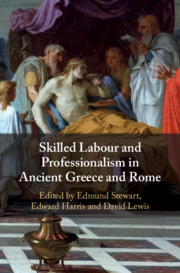Book contents
- Skilled Labour and Professionalism in Ancient Greece and Rome
- Skilled Labour and Professionalism in Ancient Greece and Rome
- Copyright page
- Contents
- Illustrations
- Contributors
- Acknowledgements
- Abbreviations
- Introduction
- Part I Professionals and Professional Identity in Greece and Rome
- 1 Many Ancient Greek Occupations, but Few Professions
- 2 Skilled Workers in the Ancient Greek City: Public Employment, Selection Methods, and Evaluation
- 3 Money Making, ‘Avarice’, and Elite Strategies of Distinction in the Roman World
- Part II Specialization and the Division of Labour in the Ancient City
- Part III Case Studies of Professions 1: Sculpture
- Part IV Case Studies of Professions 2: Music and Athletics
- Part V Case Studies of Professions 3: A Profession of Arms?
- Index
- References
3 - Money Making, ‘Avarice’, and Elite Strategies of Distinction in the Roman World
from Part I - Professionals and Professional Identity in Greece and Rome
Published online by Cambridge University Press: 18 September 2020
- Skilled Labour and Professionalism in Ancient Greece and Rome
- Skilled Labour and Professionalism in Ancient Greece and Rome
- Copyright page
- Contents
- Illustrations
- Contributors
- Acknowledgements
- Abbreviations
- Introduction
- Part I Professionals and Professional Identity in Greece and Rome
- 1 Many Ancient Greek Occupations, but Few Professions
- 2 Skilled Workers in the Ancient Greek City: Public Employment, Selection Methods, and Evaluation
- 3 Money Making, ‘Avarice’, and Elite Strategies of Distinction in the Roman World
- Part II Specialization and the Division of Labour in the Ancient City
- Part III Case Studies of Professions 1: Sculpture
- Part IV Case Studies of Professions 2: Music and Athletics
- Part V Case Studies of Professions 3: A Profession of Arms?
- Index
- References
Summary
Literary condemnations of manual work and commerce and trade were a discourse of social distinction that emphasized philosophical morality over avaricious money making. It did not matter socially beyond its immediate intellectual context, and neither prevented artisans and professionals from publicly displaying pride in their work nor imperial elites from treating traders, engineers, and artisans with dignity and respect in their personal interactions.
- Type
- Chapter
- Information
- Publisher: Cambridge University PressPrint publication year: 2020
References
- 1
- Cited by

